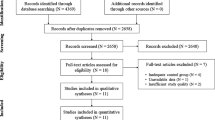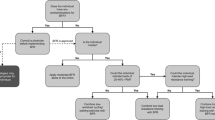Abstract
Background
Low-load resistance training (< 50% of one-repetition maximum [1RM]) associated with blood-flow restriction (BFR-RT) has been thought to promote increases in muscle strength and mass. However, it remains unclear if the magnitude of these adaptations is similar to conventional high-load resistance training (> 65% 1RM; HL-RT).
Objective
To compare the effects of HL- versus BFR-RT on muscle adaptations using a systematic review and meta-analysis procedure.
Methods
Studies were identified via electronic databases based on the following inclusion criteria: (a) pre- and post-training assessment of muscular strength; (b) pre- and post-training assessment of muscle hypertrophy; (c) comparison of HL-RT vs. BFR-RT; (d) score ≥ 4 on PEDro scale; (e) means and standard deviations (or standard errors) are reported from absolute values or allow estimation from graphs. If this last criterion was not met, data were directly requested from the authors.
Results
The main results showed higher increases in muscle strength for HL- as compared with BFR-RT, even when considering test specificity, absolute occlusion pressure, cuff width, and occlusion pressure prescription. Regarding the hypertrophic response, results revealed similar effects between HL- and BFR-RT, regardless of the absolute occlusion pressure, cuff width, and occlusion pressure prescription.
Conclusions
Based on the present data, maximum muscle strength may be optimized by specific training methods (i.e., HL-RT) while both HL- and BFR-RT seem equally effective in increasing muscle mass. Importantly, BFR-RT is a valid and effective approach for increasing muscle strength in a wide spectrum of ages and physical capacity, although it may seem particularly of interest for those individuals with physical limitations to engage in HL-RT.










Similar content being viewed by others
References
Coffey TH. Delorme method of restoration of muscle power by heavy resistance exercises. Treat Serv Bull. 1946;1(2):8–11.
Campos GE, Luecke TJ, Wendeln HK, et al. Muscular adaptations in response to three different resistance-training regimens: specificity of repetition maximum training zones. Eur J Appl Physiol. 2002;88(1–2):50–60. doi:10.1007/s00421-002-0681-6.
Kraemer WJ, Ratamess NA. Fundamentals of resistance training: progression and exercise prescription. Med Sci Sports Exerc. 2004;36(4):674–88.
Schoenfeld BJ, Wilson JM, Lowery RP, et al. Muscular adaptations in low- versus high-load resistance training: a meta-analysis. Eur J Sport Sci. 2016;16(1):1–10. doi:10.1080/17461391.2014.989922.
ACSM. ACSM clinician profile. David T. Bernhardt, M.D. Curr Sports Med Rep. 2009;8(4):161. doi:10.1249/JSR.0b013e3181adff73.
Lixandrao ME, Ugrinowitsch C, Laurentino G, et al. Effects of exercise intensity and occlusion pressure after 12 weeks of resistance training with blood-flow restriction. Eur J Appl Physiol. 2015;115(12):2471–80. doi:10.1007/s00421-015-3253-2.
Vechin FC, Libardi CA, Conceicao MS, et al. Comparisons between low-intensity resistance training with blood flow restriction and high-intensity resistance training on quadriceps muscle mass and strength in elderly. J Strength Cond Res. 2015;29(4):1071–6. doi:10.1519/JSC.0000000000000703.
Manimmanakorn A, Hamlin MJ, Ross JJ, et al. Effects of low-load resistance training combined with blood flow restriction or hypoxia on muscle function and performance in netball athletes. J Sci Med Sport. 2013;16(4):337–42. doi:10.1016/j.jsams.2012.08.009.
Mattar MA, Gualano B, Perandini LA, et al. Safety and possible effects of low-intensity resistance training associated with partial blood flow restriction in polymyositis and dermatomyositis. Arthritis Res Ther. 2014;16(5):473. doi:10.1186/s13075-014-0473-5.
Slysz J, Stultz J, Burr JF. The efficacy of blood flow restricted exercise: a systematic review and meta-analysis. J Sci Med Sport. 2016;19(8):669–75. doi:10.1016/j.jsams.2015.09.005.
Kubo K, Komuro T, Ishiguro N, et al. Effects of low-load resistance training with vascular occlusion on the mechanical properties of muscle and tendon. J Appl Biomech. 2006;22(2):112–9.
Karabulut M, Abe T, Sato Y, et al. The effects of low-intensity resistance training with vascular restriction on leg muscle strength in older men. Eur J Appl Physiol. 2010;108(1):147–55. doi:10.1007/s00421-009-1204-5.
Yasuda T, Ogasawara R, Sakamaki M, et al. Combined effects of low-intensity blood flow restriction training and high-intensity resistance training on muscle strength and size. Eur J Appl Physiol. 2011;111(10):2525–33. doi:10.1007/s00421-011-1873-8.
Martin-Hernandez J, Marin PJ, Menendez H, et al. Muscular adaptations after two different volumes of blood flow-restricted training. Scand J Med Sci Sports. 2013;23(2):e114–20. doi:10.1111/sms.12036.
Clark BC, Manini TM, Hoffman RL, et al. Relative safety of 4 weeks of blood flow-restricted resistance exercise in young, healthy adults. Scand J Med Sci Sports. 2011;21(5):653–62. doi:10.1111/j.1600-0838.2010.01100.x.
Laurentino GC, Ugrinowitsch C, Roschel H, et al. Strength training with blood flow restriction diminishes myostatin gene expression. Med Sci Sports Exerc. 2012;44(3):406–12. doi:10.1249/MSS.0b013e318233b4bc.
Ozaki H, Yasuda T, Ogasawara R, et al. Effects of high-intensity and blood flow-restricted low-intensity resistance training on carotid arterial compliance: role of blood pressure during training sessions. Eur J Appl Physiol. 2013;113(1):167–74. doi:10.1007/s00421-012-2422-9.
Thiebaud RS, Loenneke JP, Fahs CA, et al. The effects of elastic band resistance training combined with blood flow restriction on strength, total bone-free lean body mass and muscle thickness in postmenopausal women. Clin Physiol Funct Imaging. 2013;33(5):344–52. doi:10.1111/cpf.12033.
Ellefsen S, Hammarstrom D, Strand TA, et al. Blood flow-restricted strength training displays high functional and biological efficacy in women: a within-subject comparison with high-load strength training. Am J Physiol Regul Integr Comp Physiol. 2015;309(7):R767–79. doi:10.1152/ajpregu.00497.2014.
Libardi CA, Chacon-Mikahil MP, Cavaglieri CR, et al. Effect of concurrent training with blood flow restriction in the elderly. Int J Sports Med. 2015;36(5):395–9. doi:10.1055/s-0034-1390496.
Buckner SL, Jessee MB, Mattocks KT, et al. Determining strength: a case for multiple methods of measurement. Sports Med. 2017;47(2):193–5. doi:10.1007/s40279-016-0580-3.
Loenneke JP, Kim D, Fahs CA, et al. Effects of exercise with and without different degrees of blood flow restriction on torque and muscle activation. Muscle Nerve. 2014;. doi:10.1002/mus.24448.
Loenneke JP, Fahs CA, Rossow LM, et al. Effects of cuff width on arterial occlusion: implications for blood flow restricted exercise. Eur J Appl Physiol. 2012;112(8):2903–12. doi:10.1007/s00421-011-2266-8.
Loenneke JP, Fahs CA, Rossow LM, et al. Blood flow restriction pressure recommendations: a tale of two cuffs. Front Physiol. 2013;4:249. doi:10.3389/fphys.2013.00249.
Verhagen AP, de Vet HC, de Bie RA, et al. The Delphi list: a criteria list for quality assessment of randomized clinical trials for conducting systematic reviews developed by Delphi consensus. J Clin Epidemiol. 1998;51(12):1235–41.
Higgins JP, Thompson SG, Deeks JJ, et al. Measuring inconsistency in meta-analyses. BMJ. 2003;327(7414):557–60. doi:10.1136/bmj.327.7414.557.
Schoenfeld BJ, Ogborn D, Krieger JW. Dose-response relationship between weekly resistance training volume and increases in muscle mass: a systematic review and meta-analysis. J Sports Sci. 2016. doi:10.1080/02640414.2016.1210197.
Takarada Y, Takazawa H, Sato Y, et al. Effects of resistance exercise combined with moderate vascular occlusion on muscular function in humans. J Appl Physiol (1985). 2000;88(6):2097–106.
Cook SB, Murphy BG, Labarbera KE. Neuromuscular function after a bout of low-load blood flow-restricted exercise. Med Sci Sports Exerc. 2013;45(1):67–74. doi:10.1249/MSS.0b013e31826c6fa8.
Becker R, Awiszus F. Physiological alterations of maximal voluntary quadriceps activation by changes of knee joint angle. Muscle Nerve. 2001;24(5):667–72.
Moore DR, Burgomaster KA, Schofield LM, et al. Neuromuscular adaptations in human muscle following low intensity resistance training with vascular occlusion. Eur J Appl Physiol. 2004;92(4–5):399–406. doi:10.1007/s00421-004-1072-y.
Mitchell CJ, Churchward-Venne TA, West DW, et al. Resistance exercise load does not determine training-mediated hypertrophic gains in young men. J Appl Physiol (1985). 2012;113(1):71–7. doi:10.1152/japplphysiol.00307.2012.
Morton RW, Oikawa SY, Wavell CG, et al. Neither load nor systemic hormones determine resistance training-mediated hypertrophy or strength gains in resistance-trained young men. J Appl Physiol (1985). 2016;121(1):129–38. doi:10.1152/japplphysiol.00154.2016.
Sugaya M, Yasuda T, Suga T, et al. Change in intramuscular inorganic phosphate during multiple sets of blood flow-restricted low-intensity exercise. Clin Physiol Funct Imaging. 2011;31(5):411–3. doi:10.1111/j.1475-097X.2011.01033.x.
Yasuda T, Brechue WF, Fujita T, et al. Muscle activation during low-intensity muscle contractions with restricted blood flow. J Sports Sci. 2009;27(5):479–89. doi:10.1080/02640410802626567.
Crenshaw AG, Hargens AR, Gershuni DH, et al. Wide tourniquet cuffs more effective at lower inflation pressures. Acta Orthop Scand. 1988;59(4):447–51.
Counts BR, Dankel SJ, Barnett BE, et al. Influence of relative blood flow restriction pressure on muscle activation and muscle adaptation. Muscle Nerve. 2016;53(3):438–45. doi:10.1002/mus.24756.
Laurentino GC, Loenneke JP, Teixeira EL, et al. The effect of cuff cidth on cuscle adaptations after blood blow restriction training. Med Sci Sports Exerc. 2016;48(5):920–5. doi:10.1249/MSS.0000000000000833.
Loenneke JP, Fahs CA, Wilson JM, et al. Blood flow restriction: the metabolite/volume threshold theory. Med Hypotheses. 2011;77(5):748–52. doi:10.1016/j.mehy.2011.07.029.
McCall GE, Byrnes WC, Dickinson A, et al. Muscle fiber hypertrophy, hyperplasia, and capillary density in college men after resistance training. J Appl Physiol (1985). 1996;81(5):2004–12.
Takada S, Okita K, Suga T, et al. Low-intensity exercise can increase muscle mass and strength proportionally to enhanced metabolic stress under ischemic conditions. J Appl Physiol (1985). 2012;113(2):199–205. doi:10.1152/japplphysiol.00149.2012.
Cumming KT, Paulsen G, Wernbom M, et al. Acute response and subcellular movement of HSP27, alphaB-crystallin and HSP70 in human skeletal muscle after blood-flow-restricted low-load resistance exercise. Acta Physiol (Oxf). 2014;211(4):634–46. doi:10.1111/apha.12305.
Nielsen JL, Aagaard P, Bech RD, et al. Proliferation of myogenic stem cells in human skeletal muscle in response to low-load resistance training with blood flow restriction. J Physiol. 2012;590(Pt 17):4351–61. doi:10.1113/jphysiol.2012.237008.
Yasuda T, Abe T, Sato Y, et al. Muscle fiber cross-section area is increased after two weeks of twice daily KAATSU-resistance training. Int J Kaatsu Train Res. 2005;1:65–70.
Author information
Authors and Affiliations
Corresponding author
Ethics declarations
Funding
The authors are grateful to Conselho Nacional de Desenvolvimento Científico e Tecnológico (CNPq) for financial support and Fundação de Amparo à Pesquisa (FAPESP). Manoel Lixandrão is supported by CNPq and FAPESP (141733/2016-0 and 2016/22635-6, respectively). Hamilton Roschel is supported by CNPq and FAPESP (307023/2014-1 and 2016/10993-5, respectively). Carlos Ugrinowitsch is supported by CNPq (304205/2011-7 and 2016/09759-8, respectively).
Conflict of interest
Manoel Lixandrão, Carlos Ugrinowitsch, Ricardo Berton, Felipe Vechin, Miguel Conceição, Felipe Damas, Cleiton Libardi, and Hamilton Roschel declare that they have no conflicts of interest relevant to the content of this review.
Electronic supplementary material
Below is the link to the electronic supplementary material.
Rights and permissions
About this article
Cite this article
Lixandrão, M.E., Ugrinowitsch, C., Berton, R. et al. Magnitude of Muscle Strength and Mass Adaptations Between High-Load Resistance Training Versus Low-Load Resistance Training Associated with Blood-Flow Restriction: A Systematic Review and Meta-Analysis. Sports Med 48, 361–378 (2018). https://doi.org/10.1007/s40279-017-0795-y
Published:
Issue Date:
DOI: https://doi.org/10.1007/s40279-017-0795-y




